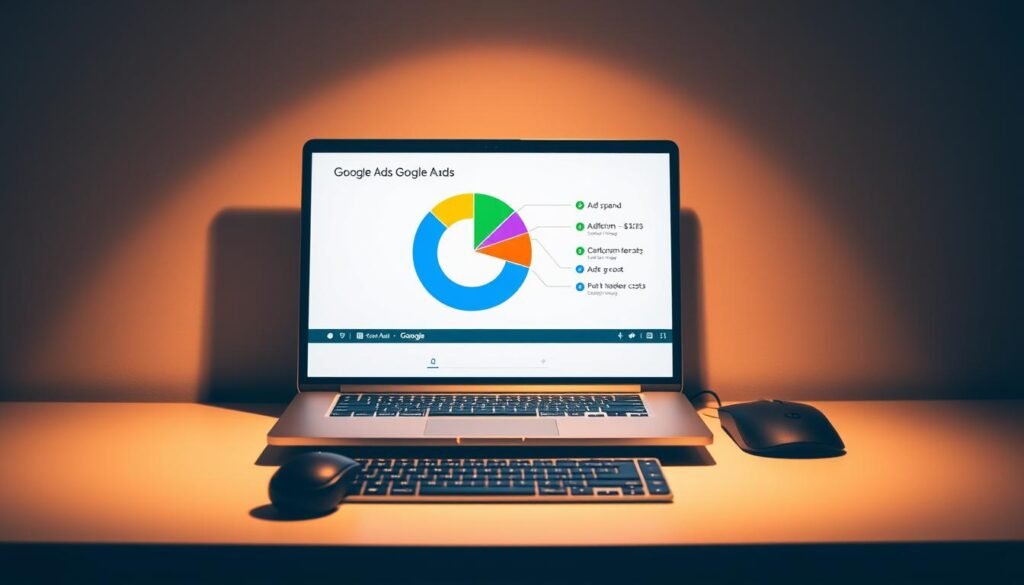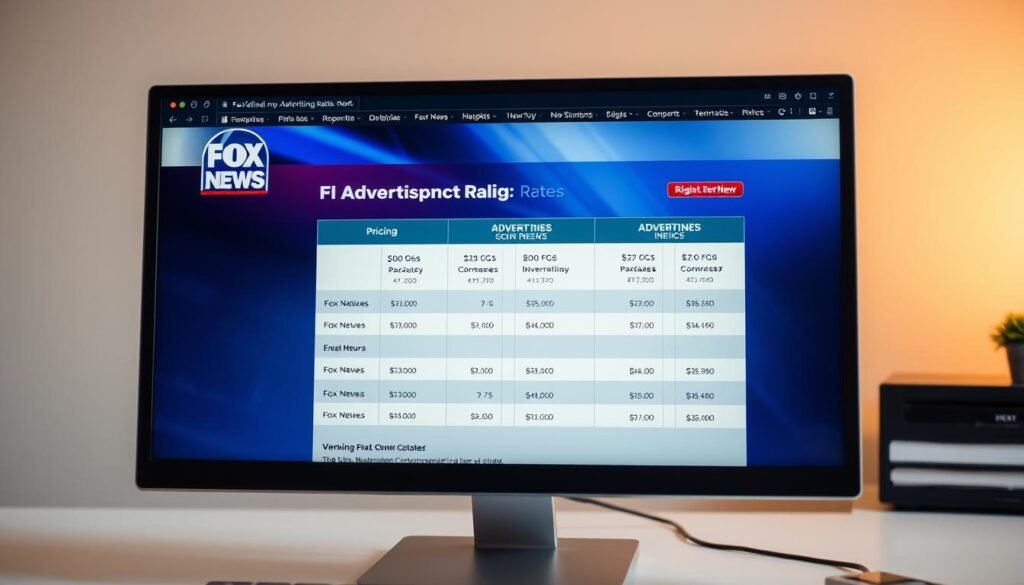Understanding Google Ads pricing is key to a successful online ad campaign. The cost can change a lot based on campaign type and targeting. Knowing how Google Ads pricing works is vital to manage your budget well.

Learning about Google Ads costs helps you plan a budget-friendly campaign. This article will cover the basics of Google Ads pricing. We’ll look at the pay-per-click model and common pricing metrics to guide your budget decisions.
Introduction to Google Ads
Google Ads is a great tool for businesses and individuals to reach online audiences. It lets you create targeted campaigns to find potential customers. Knowing about Google Ads pricing helps you set up a campaign that meets your goals without overspending.
Key Takeaways
- Understanding Google Ads pricing is crucial for creating a successful online advertising campaign
- Google Ads cost can vary depending on the type of campaign and targeting options
- The pay-per-click model is a key component of Google Ads pricing
- Common pricing metrics include cost-per-click and cost-per-conversion
- Creating a Google Ads budget requires careful planning and consideration of your marketing goals
- Google Ads pricing can be affected by factors such as industry competition and keyword bid amounts
- By understanding Google Ads pricing, you can create a campaign that helps you achieve your marketing goals and stay within your budget
Understanding the Basics of Google Ads Costs
Managing your Google Ads budget starts with knowing the basics. The cost of running Google Ads changes based on several factors. These include the campaign type, targeting, and bidding strategy. To make the most of your budget, it’s key to grasp the pricing models and metrics.
The Google Ads platform follows a pay-per-click (PPC) model. This means you only pay when someone clicks on your ad. It’s designed to help you reach your audience and drive conversions. There are also different types of Google Ads campaigns, like search, display, and video ads. Each has its own pricing and strategies.
Key Pricing Metrics
- Cost-per-click (CPC): the cost of each ad click
- Cost-per-thousand impressions (CPM): the cost of displaying your ad 1,000 times
- Conversion rate: the percentage of users who complete a desired action
Knowing these key pricing metrics helps you manage your Google Ads budget better. It lets you create campaigns that really work for your business.
How Much Does It Cost to Run Google Ads: Breaking Down the Numbers
Understanding the costs of running Google Ads is key to a successful campaign. Google Ads expenses change based on many factors. These include the industry, target audience, and bidding strategy. On average, the cost-per-click for Google Ads is between $0.50 and $5.00. Some industries might pay up to $50.00 per click.
Here are some average Google Ads cost ranges for different industries:
- Average cost-per-click for retail: $0.50 – $2.00
- Average cost-per-click for finance: $1.00 – $5.00
- Average cost-per-click for healthcare: $2.00 – $10.00
The costs of running Google Ads can quickly add up. But, knowing what affects these costs helps you plan a campaign that fits your budget. This way, you can get a good return on your investment.
By looking at your Google Ads expenses and Google Ads cost, you can make smart choices for your campaign. Keep an eye on how your campaign is doing. Adjust your bidding strategy as needed to get the best value from your Google Ads cost.
Factors That Influence Your Google Ads Spending
Google Ads pricing can change based on several factors. Knowing these can help you set a good budget. The competition in your field and the keywords you choose are big factors. They can affect how much you spend on Google Ads.
Creating a well-planned campaign is key to managing your budget. A good ad quality score can lower your costs. Also, where you target your ads can change your spending.
Here are some important things to think about when managing your Google Ads spending:
- Industry competition levels and their impact on Google Ads pricing
- Keyword bid amounts and their effect on your budget for Google Ads
- Quality score and its role in determining your Google Ads costs
- Geographic targeting considerations and their influence on your spending
By considering these factors, you can make a better budget for Google Ads. This will help you reach your marketing goals. Always check and update your Google Ads pricing strategy to get the best value from your budget.
Setting Your Initial Google Ads Budget
Setting your Google Ads budget is crucial. It’s about balancing your spending with your financial goals. A smart budget helps you avoid overspending and ensures a good return on investment. Start by deciding how much you want to spend each day on Google Ads.
Understanding the cost of Google Ads is key. The cost changes based on your target audience, keywords, and ad placement. A realistic budget ensures your ads reach the right people and maximize your spend.

To set a total budget, think about your marketing goals and how much you can spend on Google Ads. Tools like the Google Ads budget planner can help estimate costs. A well-planned budget is vital for a successful campaign and reaching your marketing goals.
When setting your Google Ads budget, consider these points:
- Set a daily budget that fits your budget.
- Know how the cost of Google Ads impacts your budget.
- Use tools like the Google Ads budget planner to estimate costs.
Understanding Bidding Strategies and Their Cost Implications
Choosing the right bidding strategy is key to managing Google Ads expenses. The cost of Google Ads can change a lot based on your bidding choice. It’s important to know the different strategies and how they affect costs.
Manual and automated bidding are two main options. Manual bidding lets you control your bids but takes time. Automated bidding uses algorithms for better bids but might not meet your exact goals.
Bidding Strategy Options
- Cost-per-click (CPC) bidding: You pay each time a user clicks your ad.
- Cost-per-thousand impressions (CPM) bidding: You pay for every 1,000 times your ad is shown.
- Cost-per-conversion (CPA) bidding: You pay for each conversion, such as a sale or sign-up.
Knowing the cost of each strategy is crucial for better Google Ads campaigns. By picking the right strategy, you can control costs and get more value from your ads.
Hidden Costs and Fees to Consider
When planning your Google Ads budget, remember the hidden costs and fees. Management fees can quickly add up. Ad creation costs and landing page development costs are also important to include.
Let’s look at these costs in detail:
- Management fees: These are what agencies or professionals charge for managing your Google Ads campaigns.
- Ad creation costs: This includes the cost of making ad copy, images, and videos for your campaigns.
- Landing page development costs: This covers the cost of creating and improving landing pages for your campaigns.
Knowing about these hidden costs is key to a good Google Ads budget. By understanding Google Ads pricing and budgeting, businesses can avoid surprises and run successful campaigns.

Tips for Optimizing Your Ad Spend
To cut down on Google Ads costs, it’s key to keep your ad campaigns in top shape. Regular optimization can help lower your expenses and boost your return on investment. Start by focusing on keyword optimization. This means doing deep keyword research and setting up targeted ad groups.
Also, work on making your ads better. Write catchy ad copy and use eye-catching visuals. This can help get more clicks and conversions, which lowers your cost per acquisition.
It’s also important to manage your budget wisely. Put more money into the ad groups and campaigns that do well. Stop spending on those that don’t. This way, you can make the most of your money and reduce Google Ads costs. Some effective strategies include:
- Regularly check how your ads are doing
- Change your bids and budgets as needed
- Use Google Ads’ automated bidding strategies
By following these tips, you can make the most of your ad spend. This will help you save on Google Ads costs and get a better return on investment. Always keep an eye on your ad campaigns and make changes as needed to get the best results.
Measuring ROI and Cost-Effectiveness
To get the most out of your Google Ads budget, it’s key to measure ROI and cost-effectiveness. You need to track important performance indicators (KPIs). These help you see how your ads are doing and find ways to get better.
Tracking KPIs like conversion rate, cost-per-conversion, and return on ad spend (ROAS) is crucial. These metrics give you insights into your ads’ effectiveness. They help you make smart decisions about where to put your Google Ads budget. For example, if a certain ad group has a high conversion rate but low ROAS, you might need to tweak your strategy.
Here are some tips to help you calculate ROAS and measure your Google Ads campaigns’ cost-effectiveness:
- Track your conversions and revenue from your ads
- Keep an eye on your Google Ads cost and adjust your budget as needed
- Use Google Ads reporting tools to analyze your campaign performance and find ways to improve
By following these tips and keeping an eye on your KPIs, you can make sure your Google Ads budget is used well. Always look for ways to make your campaigns more cost-effective and get a better ROI.
Common Budget Mistakes to Avoid
Managing Google Ads expenses requires knowing common budget mistakes. Overspending is a big error, happening when you don’t set realistic targets. To avoid this, set a clear budget and watch your ad spend closely.
Another mistake is not tracking return on investment (ROI). This makes it hard to see how well your Google Ads are doing. By watching your ROI, you can find ways to improve and adjust your pricing. Important metrics include conversion rates and cost per acquisition.
To avoid these mistakes, follow these tips:
- Set a realistic budget and regularly review your Google Ads expenses
- Monitor your ROI and adjust your Google Ads pricing strategy as needed
- Optimize your ad campaigns to improve performance and reduce costs
By being aware of these mistakes and avoiding them, you can make effective Google Ads campaigns. These campaigns should meet your budget goals and help your business grow. Always check your Google Ads expenses and tweak your strategy to get the best value from your ad spend.
Tools and Resources for Budget Management
Managing a Google Ads budget can be tough, especially for beginners. The costs can pile up fast. So, it’s key to have the right tools and resources for effective budget management. Luckily, there are many options to help with Google Ads budgeting.
When planning your Google Ads budget, think about the overall cost and how it fits into your marketing plan. The right tools and resources can help you create a budget that suits your needs. This way, you can reach your marketing goals.
- Google Ads budget planner: a free tool for planning and managing your Google Ads budget
- Third-party budget management tools: such as AdEspresso and WordStream, offering advanced features
- Useful budget tracking templates: like spreadsheets and dashboards, for tracking and managing your budget
With these tools and resources, you can manage a Google Ads budget that fits your needs. Always check and adjust your budget to keep it effective and in line with your marketing strategy.
Conclusion: Making Your Google Ads Budget Work Smarter
Managing your Google Ads cost and Google Ads budget is key to success. Understanding what affects your ad spend and using smart budget strategies can make your Google Ads worth it.
Keep an eye on your campaigns, make changes, and check how much you’re getting back. Look at your performance often, try new bidding methods, and tweak your campaigns to save money. Use tools and resources to help manage your budget and learn more.
With a smart Google Ads plan, you can get the most out of your marketing. Stay focused, be ready to change, and aim for real results from your ads.
FAQ
What is the pay-per-click (PPC) model in Google Ads?
The pay-per-click (PPC) model in Google Ads means you only pay when someone clicks on your ad. This way, you only spend money when someone actually sees your ad and clicks on it. It’s a smart way to save money and target your ads better.
What are the different types of Google Ads campaigns?
Google Ads has many types of campaigns. You can choose from search ads, display ads, video ads, and shopping ads. Each type has its own pricing and features, so pick the one that fits your budget and goals.
What are common pricing metrics in Google Ads?
In Google Ads, you’ll see two main pricing metrics. Cost-per-click (CPC) is how much you pay for each ad click. Cost-per-thousand impressions (CPM) is the cost for every 1,000 times your ad is shown.
How much does it typically cost to run Google Ads campaigns?
The cost of Google Ads varies a lot. It depends on your industry, competition, and how much you bid on keywords. On average, you might spend $1 to $2 per click, but it can be more or less.
What factors influence Google Ads spending?
Several things can affect how much you spend on Google Ads. These include how competitive your industry is, your keyword bids, your ad quality, and where you target your ads. Knowing these can help you manage your costs and get the most from your ads.
How do I set an initial Google Ads budget?
Setting a Google Ads budget starts with knowing your marketing goals and who you want to reach. Start with a daily budget that fits your overall marketing budget. Then, adjust it based on how well your ads are doing.
What are the cost implications of different bidding strategies in Google Ads?
Your bidding strategy in Google Ads can really affect your costs. Manual bidding gives you more control but takes more time. Automated bidding can optimize your bids but might cost more per click.
What hidden costs and fees should I consider in Google Ads?
Besides the ad costs, there are other expenses to think about. These include management fees, creating ads, and making landing pages. Knowing these extra costs helps you budget better for your campaigns.
How can I optimize my Google Ads spend?
To get the most from your Google Ads, focus on keywords, improve your ad quality, and manage your budget well. Keep an eye on your campaigns and make changes as needed to use your budget wisely.
How do I measure the ROI and cost-effectiveness of my Google Ads campaigns?
To check if your Google Ads are worth it, track important metrics like conversion rate and cost-per-conversion. Understanding these helps you make smart decisions about your budget and improve your campaigns.
What are some common budget mistakes to avoid in Google Ads?
Avoid spending too much, too little, or not tracking your ROI. By being careful and using smart budget strategies, you can run successful and cost-effective Google Ads campaigns.
What tools and resources are available for managing my Google Ads budget?
Google Ads has a budget planner tool to help you manage your budget. There are also third-party tools and templates to help track and optimize your spending on Google Ads.




































